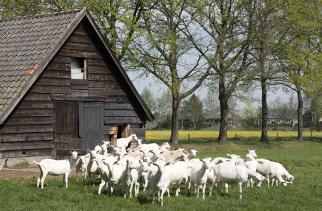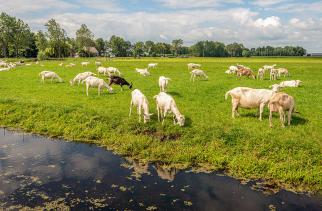Senior onderzoeker Rampen en Milieudreigingen
Publicatie
Publicatie datum
Prevalence of non-specific health symptoms in livestock dense areas: looking beyond respiratory conditions.
Gerbecks, J., Baliatsas, C., Yzermans, C.J., Smit, L.A.M., Huss, A., Heederik, D.J.J., Dückers, M.L.A. Prevalence of non-specific health symptoms in livestock dense areas: looking beyond respiratory conditions. International Journal of Hygiene and Environmental Health: 2020, 230, p. 113603.
Download de PDF
Aim
The aim of this study was to gain more insight in the association between prevalence of diverse acute non-specific symptoms (NSS) and livestock density as a possible risk factor among residents of livestock-dense and non-dense regions, taking into account socio-demographic factors and psychological morbidity.
Method
Prevalence of NSS and psychological morbidity were assessed for the year 2017, based on electronic health records from 39 general practices in the Netherlands. The study group consisted of people who lived in rural areas with high numbers of livestock (n = 74093), while the control group included people in rural areas with low numbers of livestock (n = 50139). For a large portion of the study group, exposure estimates (to livestock) were calculated. Multiple logistic multilevel regression analyses were performed. Two methods were used: 1) area comparisons between study and control areas in relation to health problems, and 2) estimates of livestock exposure (to goats, poultry, pigs, and cattle) within the study area.
Findings
It was found that prevalence of diarrhea, headache, sleep disturbance, respiratory symptoms, and skin problems were higher in the study group. The data suggest that there may be a protective effect of livestock exposure: in general, there was a lower risk of NSS closer to livestock (within the exposure analyses).
Interpretation
The study suggests that the previously identified higher risk of respiratory health problems in livestock dense areas might also apply to the prevalence of various other NSS. Longitudinal research taking into account different or more individual and contextual characteristics could possibly elucidate why prevalence of NSS in closer proximity to livestock is lower compared to people who live further away, whilst a more overarching analysis indicated that living in livestock dense areas was associated with more NSS.
The aim of this study was to gain more insight in the association between prevalence of diverse acute non-specific symptoms (NSS) and livestock density as a possible risk factor among residents of livestock-dense and non-dense regions, taking into account socio-demographic factors and psychological morbidity.
Method
Prevalence of NSS and psychological morbidity were assessed for the year 2017, based on electronic health records from 39 general practices in the Netherlands. The study group consisted of people who lived in rural areas with high numbers of livestock (n = 74093), while the control group included people in rural areas with low numbers of livestock (n = 50139). For a large portion of the study group, exposure estimates (to livestock) were calculated. Multiple logistic multilevel regression analyses were performed. Two methods were used: 1) area comparisons between study and control areas in relation to health problems, and 2) estimates of livestock exposure (to goats, poultry, pigs, and cattle) within the study area.
Findings
It was found that prevalence of diarrhea, headache, sleep disturbance, respiratory symptoms, and skin problems were higher in the study group. The data suggest that there may be a protective effect of livestock exposure: in general, there was a lower risk of NSS closer to livestock (within the exposure analyses).
Interpretation
The study suggests that the previously identified higher risk of respiratory health problems in livestock dense areas might also apply to the prevalence of various other NSS. Longitudinal research taking into account different or more individual and contextual characteristics could possibly elucidate why prevalence of NSS in closer proximity to livestock is lower compared to people who live further away, whilst a more overarching analysis indicated that living in livestock dense areas was associated with more NSS.
Aim
The aim of this study was to gain more insight in the association between prevalence of diverse acute non-specific symptoms (NSS) and livestock density as a possible risk factor among residents of livestock-dense and non-dense regions, taking into account socio-demographic factors and psychological morbidity.
Method
Prevalence of NSS and psychological morbidity were assessed for the year 2017, based on electronic health records from 39 general practices in the Netherlands. The study group consisted of people who lived in rural areas with high numbers of livestock (n = 74093), while the control group included people in rural areas with low numbers of livestock (n = 50139). For a large portion of the study group, exposure estimates (to livestock) were calculated. Multiple logistic multilevel regression analyses were performed. Two methods were used: 1) area comparisons between study and control areas in relation to health problems, and 2) estimates of livestock exposure (to goats, poultry, pigs, and cattle) within the study area.
Findings
It was found that prevalence of diarrhea, headache, sleep disturbance, respiratory symptoms, and skin problems were higher in the study group. The data suggest that there may be a protective effect of livestock exposure: in general, there was a lower risk of NSS closer to livestock (within the exposure analyses).
Interpretation
The study suggests that the previously identified higher risk of respiratory health problems in livestock dense areas might also apply to the prevalence of various other NSS. Longitudinal research taking into account different or more individual and contextual characteristics could possibly elucidate why prevalence of NSS in closer proximity to livestock is lower compared to people who live further away, whilst a more overarching analysis indicated that living in livestock dense areas was associated with more NSS.
The aim of this study was to gain more insight in the association between prevalence of diverse acute non-specific symptoms (NSS) and livestock density as a possible risk factor among residents of livestock-dense and non-dense regions, taking into account socio-demographic factors and psychological morbidity.
Method
Prevalence of NSS and psychological morbidity were assessed for the year 2017, based on electronic health records from 39 general practices in the Netherlands. The study group consisted of people who lived in rural areas with high numbers of livestock (n = 74093), while the control group included people in rural areas with low numbers of livestock (n = 50139). For a large portion of the study group, exposure estimates (to livestock) were calculated. Multiple logistic multilevel regression analyses were performed. Two methods were used: 1) area comparisons between study and control areas in relation to health problems, and 2) estimates of livestock exposure (to goats, poultry, pigs, and cattle) within the study area.
Findings
It was found that prevalence of diarrhea, headache, sleep disturbance, respiratory symptoms, and skin problems were higher in the study group. The data suggest that there may be a protective effect of livestock exposure: in general, there was a lower risk of NSS closer to livestock (within the exposure analyses).
Interpretation
The study suggests that the previously identified higher risk of respiratory health problems in livestock dense areas might also apply to the prevalence of various other NSS. Longitudinal research taking into account different or more individual and contextual characteristics could possibly elucidate why prevalence of NSS in closer proximity to livestock is lower compared to people who live further away, whilst a more overarching analysis indicated that living in livestock dense areas was associated with more NSS.
Gegevensverzameling




